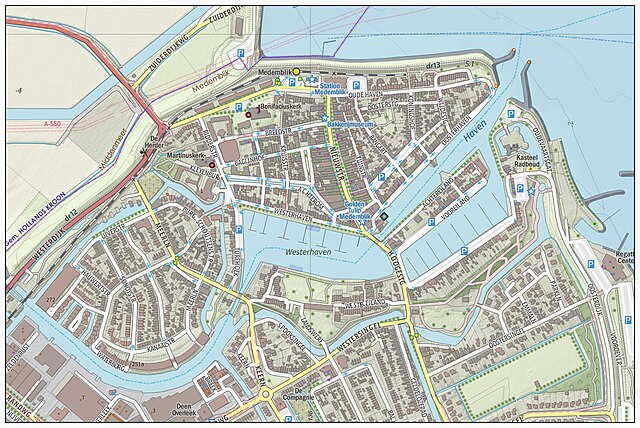User:Esther Medemblik/Medemblik (town)

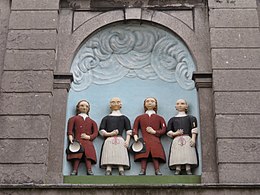

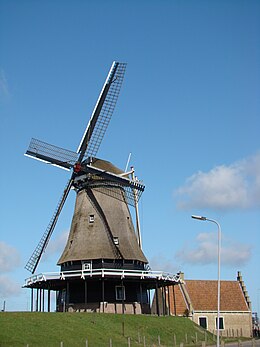
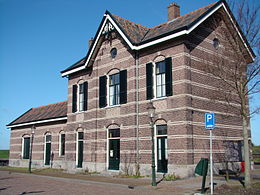
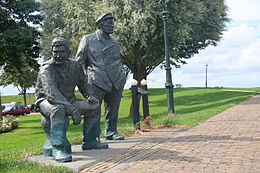
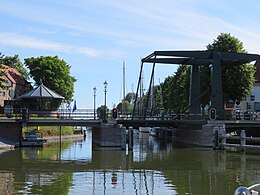
Medemblik (ⓘ) is a city in the eponymous municipality of Medemblik in the Dutch province of North-Holland. It is located in West-Friesland by the IJsselmeer. As of 1 August 2013, the city has 8,492 residents (source: Municipality of Medemblik).
Medemblik is the oldest town in West Friesland: it was granted city rights by Count Floris V , who had then just subjected West Friesland to his count’s authority. Until 2007 Medemblik was an independent municipality, to which no other towns belonged. The municipality was one of the smallest in the province of North Holland. The current municipality of Medemblik arose from a merger with the municipality Noorder-Koggenland and Wognum on 1 January 2007, followed by a merger with the municipalities of Wervershoof and Andijk per 1 januari 2011.
Toponymy
[edit]The name "Medemblik" possibly derives from the watercourse Medemelake or Medemelacha (Germanic miduma- "middle" and laku- "watercourse in marshy land"[2]) that ran at this location, and was mentioned in records from 985. Medemblik itself is named in this as "villa Medemelacha". Although this peat stream has at present largely vanished, the remaining section is still known as the Kromme Leek and flows through the lakes Groote en Kleine Vliet near Medemblik out into the IJsselmeer.
History
[edit]Medemblik en Dorestad developed thriving markets due to the Frisians.[3] In 1289, Medemblik was the first town in West Friesland to be granted city rights by Count Floris V, after he had subdued the West Frisians. He had a citadel constructed at this time, which is now known as Radboud Castle. In 1517 the city was plundered by the army of Johan van Selbach, supported by the privateers of Grutte Pier and Wijerd Jelckama. A major city fire took place in Medemblik in 1555. At the start of the Eighty Years’ War, in 1572 and 1588, the town was besieged by geuzen and royal troops respectively.
Medemblik’s important declined considerably due to the opening of the Noordhollandsch Kanaal in 1824. The closing off of the Zuiderzee proved to be the final blow for Medemblik, although in the 1970s the town developed into a well-known centre for water sports, with a particularly lively night-life in peak season.
Medemblik boasts many historic façades, and a town hall from 1939 by architect A.J. Kropholler. There is also an operational corn mill (Molen De Herder, rebuilt 1986-1990) and the Netherlands Stoommachinemuseum is housed in the former pumping station De Vier Noorder Koggen. Medemblik has more than 80 national monuments. Museumsteamtram Hoorn-Medemblik
Medemblik has had a rail connection with Hoorn since 1887 . Medemblik's station building dates from the opening year. This line is currently used by the Museumstoomtram Hoorn-Medemblik.
Landmarks
[edit]As an old town, Medemblick has a large number of landmarks. Here can be found a great deal of old buildings from the 16th, 17th and 18th century:
• Cloister beside the Sint-Martinuskerk
• Various buildings on the Westerhaven, such as the "Dijkhuis"
• The warehouse "De Wolff" from 1667 on Vooreiland
• Historic building "Het hof van Medemblick"
• The three warehouses named "De Hoop" on Vooreiland
• The "Scheve Huis" on Vooreiland
• The only house in Medemblick in Louis XVI style, from 1728
• Former synagogue on Gedempt Achterom, from where Medemblik’s Jews where transported during the Second World War
• War monuments for Medemblik’s fallen soldiers, Jews and resistance fighters; although this is used as such it had already been erected before the Second World War as a memorial to the Dutch garrison that had been stationed in Medemblick, and thus in fact has nothing to do with the Second World War. It lies on the intersection of Nieuwstraat and Breedstraat.
• Oosterhaven 21, historic residence from the 18th century
• The canal house "Moeder Engelen" on Achterom
• The warehouse of West India Company on Oosterhaven
• The Reformed Orphanage "De Vier Weeskinderen" with gate from 1795 on Torenstraat; the images of orphans above the gate once featured on a Dutch postage stamp;
• The Waag on Kaasmarkt
• The "Koggehuis" from 1613 on Nieuwstraat
• The Town Hall (former since 2011), with remains of the old town hall on the Dam; before 1941, the Town Hall was slightly further along on Nieuwstraat;
• Medemblik Station is part of the track of the Hoorn-Medemblik heritage railway
• "De Opper", opposite windmill "De Herder", wooden management residence of Zuiderzee Works
• The "Swarte Woifke", built in 1640 and renovated in 1740 and 1780 on Oosterhaven
• The "Witte Huys", on Vooreiland, at the junction with Hoogesteeg, now a clothes shop.
Other important monuments are:
• The 16th-century canal "Het Achterom", the final canal within the centre, radically restored in the 1970s.
• The Urban Farms
• The "Dijkhuis" from 1599
• "Landswerf", built 1799-1800, tower 1808, once used as accommodation by the navy and then a Provincial Hospital (for the mental disturbed), empty from 1966 and then in the 1980s set up as an apartment complex, in the middle of a park;
• The corn mill "De Herder" (destroyed in 1948, rebuilt in 1986-90 with a lot of new material although old components from 1695 from a mill shell "De Herder" from Jisp, later Willeskop, were also used, for which reason the name was retained and his mill is a national monument)
• "Radboud Castle" (1286-1288), restored in 1888 following disrepair
• The Dutch Steam Museum from 1869 (also Stoomgemaal Vier Noorder Koggen)
• The "Murrayhouse" with views over the grave of Lord George Murray
• Widows’ House from 1500
• The "Belasting-Huys" on Torenstraat and Westerhaven
• The "Koersen-Huys" to the left of the Belasting-Huys
• Building on Begijnhof in renaissance style
• The "Waterschapshuis" with swinging bell in the roof-turret, on Westerhaven.
• The "Regthuys", recognisable due to a lantern just above the door, situated on Westerhaven
• The "Roze Huis", birthplace of the architect who built the original mills at the "Vier Noorder Koggen" polder, new a steam-engine pump stands on that site.
• The "De Oude Bakkerij” bakery museum
• The Main Post Office, on Van Houwingepark in the town centre, now no longer used
• Remains of the Eastern Gate for Radboud Castle
• The oldest moment for commemorating the Second World War on Nieuwstraat.
Churches and other religious buildings:
• Bonifaciuskerk with tower from 1404, the town’s oldest building
• Sint-Martinuskerk from 1902, Gothic Revival
• N.H. Domineehuis
• Doopsgezinde schuilkerk on Tuinstraat ufrom 1675
• Municipal Aula from 1666, used as a school until 1972, restored in 1982
• Evangelical Lutheran Church from 1650-1700, on Westerhaven. Now a painting studio
A part of Medemblik is a protected villagescape, with the harbour and the church surroundings. The town also has dozens of national monuments.
Map of the old centre of Medemblik
Traffic and transport
[edit]Medemblik can be reached from .Amsterdam, Hoorn, Leeuwarden and Den Oever via the A7 and the N239. From Hoogkarspel via the N240.
Notable people
[edit]- Jan Albertsz Rotius (1624), painter
- Louise Kaiser (1891–1973), the first female lecturer at the University of Amsterdam
- Simon Buis (1892) Dutch Roman Catholic priest and missionary
- Sam Pormes (1954), politician (GroenLinks)
- Willem Vogelsang (1956), linguistic
- Marijke Zeekant (1956), triathlete, duathlete, rower
See also
[edit]- List of former Zuiderzee towns
External link
[edit]| Bronnen, noten en/of referenties
|
[[Category:Medemblik]] [[Category:Populated places in North Holland]]

